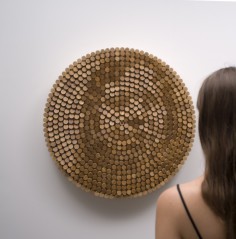Daniel Rozin
丹尼尔·罗津
ДАНИЭЛЬ РОЗИН
Peg Mirror

source: youtube
Rozin’s Peg Mirror comprises 650 circular wooden pieces that are cut on an angle. Casting shadows by twisting and rotating in unison, wooden pegs forming concentric circles surround a small central camera. The mirrored image produced in this work is activated by software authored by Rozin that processes video signals and breaks up imagery geometrically, seemingly pixel by pixel. The silently moving wood components in this piece flicker like jewels or coins in the spotlight, challenging our notions about what constitutes a “digital object”.
.
.
.
.
.
.
.
source: smoothware
Mechanical Mirrors:
The mechanical mirrors are made of various materials but share the same behavior and interaction; any person standing in front of one of these pieces is instantly reflected on its surface. The mechanical mirrors all have video cameras, motors and computers on board and produce a soothing sound as the viewer interacts with them.
Peg Mirror – 2007
Peg Mirror comprises 650 circular wooden pieces that are cut on an angle. Casting shadows by twisting and rotating, wooden pegs forming concentric circles surround a small central camera. The mirrored image produced in this work is activated by software authored by Rozin that processes video signals and breaks up imagery geometrically, seemingly pixel by pixel. The silently moving wood components in this piece flicker like jewels or coins in the spotlight, challenging our notions about what constitutes a “digital object”.
.
.
.
.
.
.
.
source: darkmattersart
Daniel Rozin was born in Jerusalem in 1961. Based in New York, Rozin creates interactive installations and sculptures that have the unique ability to change and respond to the presence of a viewer. In many of his works, the viewer takes part, actively and creatively, in the performance of his art.
.
.
.
.
.
.
source: fandesign2010wordpress
Les travaux de Daniel Rozin se concentrent sur les miroirs : il fabrique un miroir mécanique composé de multiples pièces identiques en bois. Au milieu de miroir, il y a une petit camera qui s’occupe capturer des images des visiteurs, puis transfert au l’ordinateur qui traite images comme les signaux physiques. Derrière des pièces en bois, il y a des moteurs qui organisent les déplacements après reçu les signaux. En jouant avec leur orientation par rapport à une lumière, il réussit à reproduire l’image de l’observateur, comme un reflet dans un miroir véritable.
.
.
.
.
.
.
source: re-actornet
Рассказывать о самом Даниэле бессмысленно, поэтому предлагаем вам просто ощутить, что такое интерактивные картины, гравюры, скульптуры, впитывающие в себя окружающий мир и отображающие это.
Материал для создания своих работ Даниэль Розин (Daniel Rozin) находит в повседневной жизни. Это может быть что угодно – фанера, страницы журнала или просто выброшенная упаковка. Но всего этого не было бы без интерактивных дисплеев, которые являются авторской разработкой Даниэля. Самыми популярными являются именно дисплеи, которые способны рисовать портрет смотрящего в него человека, по определенным логическим последовательностям. К чему это я? Просто смотрите.

